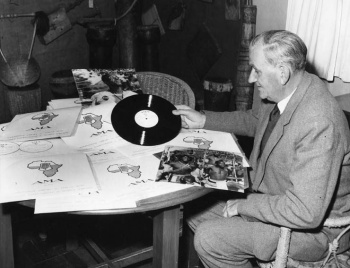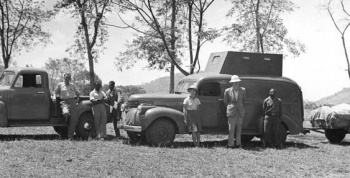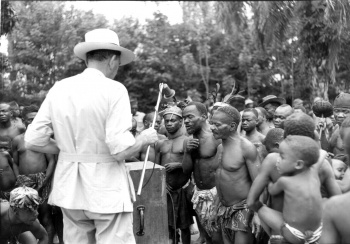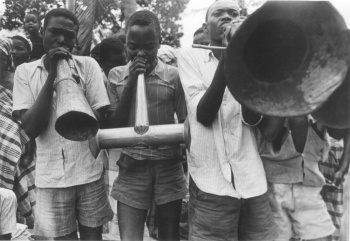Hugh Traceys Portrait

Hugh Tracey's Portrait
Hugh Tracey began studying African music in 1921, when he arrived from Devonshire, England in Southern Rhodesia (now Zimbabwe) to farm tobacco with his older brother Leonard who had been allotted land as a serviceman wounded in the First World War.
He learned the Karanga dialect of the Shona language by working with Karanga farm workers in the fields. He soon developed a love for their music and was convinced of the enormous value of music in their lives. Almost immediately, however, he became aware of the resistance of the colonial community, in particular those in education, the church and government, to any suggestion that Africans had any culture or music that was worthwhile. He knew from personal experience that this attitude was mistaken, and this was the trigger for his life’s work. In his own words, as he wrote in 1973 in the introduction to the catalogue of his major publication from his field recordings, his Sound of Africa (210 LP) series:
“The history of this collection of authentic African music, songs, legends and stories is in many ways a personal one. It dates back to the early 1920s when I first sang and wrote down the words of African songs I heard in the tobacco fields of Southern Rhodesia.
Several years later (1929) I made a number of discs with a visiting recording company (Columbia, London) when I took fourteen young Karanga men with me to record in Johannesburg, five hundred miles south. These were the first items of indigenous Rhodesian music to be recorded and published. Shortly afterwards several of these items were used by John Hammond of CBS, at Carnegie Hall in New York as preliminary music to his program on the historic occasion when he presented on the stage, for the first time in that city, the music and the personnel of a number of southern Negro bands.

Field Crew
In 1931, Mr. Harold Jowitt, the Director of Native Development, was instrumental in obtaining for me a small Carnegie Fellowship grant to study the background of the music of Southern Rhodesia. This field work was done between June 1932 and July 1933 when I recorded over 600 items on plain aluminum discs with a very early model of a portable recording machine.”
[Hugh Tracey fails to mention that the self-same Jowitt, offended by the comments in Hugh Tracey’s report to Carnegie to the effect that the missionary churches were causing irreparable damage to African culture wherever they had set foot, failed to transmit the ground-breaking report to the Carnegie Foundation, and it was never published as a result. This fact was only discovered forty years later in the 1970s!]
“As it was not possible at the time, in 1933, to make copies of these recordings, I again took Karanga musicians down south to take advantage of the temporary visit of another professional team of recording engineers. Several of the sixteen performers had already come with me on the previous occasion.
These early discs (78 RPM), together with those of the Rev. A.M Jones in Northern Rhodesia (Zambia) and a few contemporary commercial recordings of ‘town music’, ushered in a new era in the study of folk music in Rhodesia and from then onwards ripples have spread outwards through the whole of Central and Southern Africa.
At that time the public showed little interest in African music and did not understand why I constantly stressed the social and artistic value of the music for future generations of Africans. In addition, recordings of tribal music, however good, were not considered to have commercial value, as they would appeal only to a limited audience which was familiar with the dialect in question, few, if any, of whom would have the necessary apparatus on which to play them. Consequently, no further research funds were available for such a purpose and for the next twelve years I took up broadcasting as a profession, taking every opportunity of introducing the elements of African music to the South African and other radio audiences.
By 1946 it seemed clear that unless someone devoted more time and energy to appraising the social value of authentic African music it would go by default, and that at a time when the various countries of Africa were contemplating the introduction of full time radio broadcasting in African vernaculars with no recorded repertoires of local music and little comprehension of the complexities of the subject. The schools and universities of Central and Southern Africa, which one would have supposed would have been the first to undertake the study of the major oral art of the country, had failed, with minor exceptions, to give African music any permanent place in their disciplines.

pygmies
This was the challenge with which we were faced in 1946. The question remained as to how it was to be met, how funds and equipment were to be obtained and what techniques should be employed to ensure that the unwritten compositions of genuine African musicians would not be ignored or thrust aside by the artificially stimulated demands of commerce and radio, and the intrusion of non-African popular music on films and records.
I had had discussions at the Royal College of Music in London in 1931 with two English composers, Ralph Vaughan Williams and Gustav Holst, when they encouraged me to concentrate upon discovering and recording the range and extent of African music of which there was at that time little reliable information, to ignore for the time being any attempt to score the music and rather to record as much as funds would allow. Future musicians and students, they maintained, would benefit from the data so gathered. Analysis of the music would then follow on a broader, sounder foundation, based upon the evidence collected on discs and not upon hearsay or romantic imagination.
It was Mr. Eric Gallo of Johannesburg who made the next part of my research possible, by providing not only headquarters from which I could work but also the financial support for my preliminary expeditions into the more remote regions. He also undertook to press and publish a proportion of my recordings [in particular those which could become 'hits' for his company]. It was in this way that our ‘African Music Research’ unit came into being (1947) and we eventually issued several hundred shellac discs (78 RPM). This was before the invention of microgroove long-playing records.
In 1948, together with Dr.Winifred Hoernle, the doyenne of South African anthropologists, we established the African Music Society and by 1953 it was clear that an independent organization would have to be set up to relieve Mr. Gallo of the financial responsibility. He had offered to continue to support our research by providing various facilities through his recording and publishing company, including the renting to us of the headquarters near Roodepoort we had already built for the purpose.
A lecture tour of several universities in Great Britain in 1953 and an appearance for the Royal African Society in London resulted in the provision of a grant by the Nuffield Foundation with which to establish a non-profit research organization under the title ‘The International Library of African Music’. On my return, the Mining Industry of Southern Africa, including the gold, copper and diamond companies of the Congo, Rhodesia and South Africa, generously doubled the grant and the work of the now independent Library began in mid 1954.

Gitonga
Since that date the Library has undertaken its own publications, provided headquarters for the African Music Society, edited and issued the annual journal ‘African Music’ and has continually endeavored to bring to the attention of the musical world the cultural importance of this aspect of folk music and the potential genius of African musicians in their own right.
When in 1960 the funds of the Library were growing low after the publication of our first 100 records in the ‘Sound of Africa’ series, I was invited by the State Department of the United States to visit America to lecture at over twenty universities which had African Studies Departments. This made it possible for me to approach the Ford Foundation and, as a result, we were fortunate enough to obtain, through their generosity, a grant which enabled us to publish an additional 100 discs from material which had already been collected on tape in the field.
It is the fruit of these years of work, with the practical support of our several benefactors, which is now available in recorded form, both in the ‘Sound of Africa’ series for educational purposes and in an edition of selected items for general release, the ‘Music of Africa’ series.
In 1969 my son Andrew joined me in research and has already added his first field recordings to our collection which will be featured in subsequent catalogues. All items on the 210 discs of the present catalogue were recorded by me personally in their districts of origin.
I would like to acknowledge my deep sense of gratitude....to the hundreds and possibly thousands of African folk musicians, composers, singers, dancers and instrumentalists who have performed for us, most of them without monetary reward of any kind but with genuine satisfaction at being able to hear themselves for the first time through the medium of electrical recording.
This series, ‘The Sound of Africa’, now provides something of the positive evidence of several distinctive styles of musical genius which they and they alone as African musicians can contribute to the sum of the great folk music of the world.”
Last Modified: Thu, 07 Mar 2024 16:32:07 SAST




